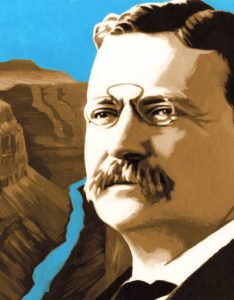Historically Speaking: In Awe of the Grand Canyon
Since the 16th century, travelers have recorded the overwhelming impact of a natural wonder.

ILLUSTRATION BY THOMAS FUCHS
Strange as it may sound, it was watching Geena Davis and Susan Sarandon in the tragic final scene of “Thelma and Louise” (1991) that convinced me I had to go to the Grand Canyon one day and experience its life-changing beauty. Nearly three decades have passed, but I’m finally here. Instead of a stylish 1966 Ford Thunderbird, however, I’m driving a mammoth RV, with my family in tow.
The overwhelming presence of the Grand Canyon is just as I dreamed. Yet I’m acutely aware of how one-sided the relationship is. As the Pulitzer Prize-winning poet Carl Sandburg wrote in “Many Hats” in 1928: “For each man sees himself in the Grand Canyon—each one makes his own Canyon before he comes.”
The first Europeans to encounter the Canyon were Spanish conquistadors searching for the legendary Seven Golden Cities of Cibola. In 1540, Hopi guides took a small scouting party led by García López de Cárdenas to the South Rim (60 miles north of present-day Williams, Ariz.). In Cárdenas’s mind, the Canyon was a route to riches. After trying for three days to find a path to reach the river below, he cut his losses in disgust and left. Cárdenas saw no point to the Grand Canyon if it failed to yield any treasure.
Three centuries later, in 1858, the first Euro-American to follow in Cárdenas’s footsteps, Lt. Joseph Christmas Ives of the U.S. Army Corps of Topographical Engineers, had a similar reaction. In his official report, Ives waxed lyrical about the magnificent scenery but concluded, “The region is, of course, altogether valueless….Ours has been the first, and will doubtless be the last, party of whites to visit this profitless locality.”
Americans only properly “discovered” the Grand Canyon through the works of artists such as Thomas Moran. A devotee of the Hudson River School of painters, Moran found his spiritual and artistic home in the untamed landscapes of the West. His romantic pictures awakened the public to the natural wonder in their midst. Eager to see the real thing, the trickle of visitors turned into a stream by the late 1880s.
The effusive reactions to the Canyon recorded by tourists who made the arduous trek from Flagstaff, Ariz. (a railway to Grand Canyon Village was only built in 1901) have become a familiar refrain: “Not for human needs was it fashioned, but for the abode of gods…. To the end it effaced me,” wrote Harriet Monroe, the founder of Poetry magazine, in 1899.
But there was one class of people who were apparently insensible to the Canyon: copper miners. Watching their thoughtless destruction of the landscape, Monroe wondered, “Do they cease to feel it?” President Theodore Roosevelt feared so, and in 1908 he made an executive decision to protect 800,000 acres from exploitation by creating the Grand Canyon National Monument.
Roosevelt’s farsightedness may have put a crimp in the profits of mining companies, but it paid dividends in other ways. By the 1950s, the Canyon had become a must-see destination, attracting visitors from all over the world. Among them were the tragic Sylvia Plath, author of “The Bell Jar,” and her husband, Ted Hughes, the future British Poet Laureate. Thirty years later, the visit to the Canyon still haunted Hughes: “I never went back and you are dead. / But at odd moments it comes, / As if for the first time.” He is not alone, I suspect, in never fully leaving the Canyon behind.
